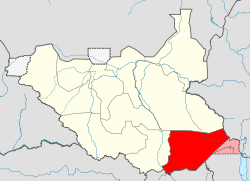Acholi people
The Acholi people (also spelled Acoli) are a Luo nation found in Magwi County in South Sudan and Northern Uganda (an area commonly referred to as Acholiland), including the districts of Agago, Amuru, Gulu, Kitgum, Nwoya, Lamwo, and Pader. Approximately 1.47 million Acholi were counted in the Uganda census of 2014, and 45,000 more were living in South Sudan in 2000.[2]
 The Acholi are a Luo people, who are said to have come to northern Uganda from the area now known as Bahr el Ghazal in South Sudan. | |
| Total population | |
|---|---|
| 1,515,554 | |
| Regions with significant populations | |
| 1,470,554[1] | |
| ~45,000 (2000) | |
| Languages | |
| Acholi | |
| Religion | |
| Roman Catholicism; Anglicanism | |
| Related ethnic groups | |
| Other Luo peoples, other Nilotic peoples | |
Language
The Acholi dialect is a Western Nilotic language, classified as Luo (or Lwo). It is mutually intelligible with Lango, Alur and other Luo languages. The Luo language and dialect is spoken by the Luo groups who are currently settled in various locations including western Kenya, Eastern Uganda, Acholiland, West Nile in Uganda, and South Sudan.
The Song of Lawino, one of the most successful African literary works, was written by Okot p'Bitek in Acholi, and later translated to English.
Location

Acholiland or "Acoli-land" (also known as the Acholi sub-region) is a necessarily inexact ethnolinguistic taxonomy that refers to the region traditionally inhabited by the Acholi. In the administrative structure of Uganda, Acholi is composed of the districts of:
It encompasses about 28,500 km2 (11,000 square miles) near the Uganda-Sudan border.[3]
Its current population is estimated to be around 600,000 individuals, or four percent of the total national population.[4] While Acholi also lives north of the South Sudanese border, the Sudanese Acholi are often excluded from the political meaning of the term "Acholiland".
The word 'Acholi' is a misnomer that became adopted for convenience over the years. It refers to people known locally as Luo Gang. That is why the Lango neighbours refer to the Acholi as Ugangi, meaning people of the home.
History
The presumed nominal forebears of the present-day Acholi group migrated South to Northern Uganda from the area now known as Bahr el Ghazal in South Sudan by about 1,000 AD. Starting in the late seventeenth century, a new sociopolitical order developed among the Luo of Northern Uganda, mainly characterized by the formation of chiefdoms headed by Rwodi (sg. Rwot, 'ruler'). The chiefs traditionally came from one clan, and each chiefdom had several villages made up of different patrilineal clans. By the mid-nineteenth century, about 60 small chiefdoms existed in eastern Acholiland.[5] During the second half of the nineteenth century, Arabic-speaking traders from the north started to call them Shooli, a term which was transformed into 'Acholi'.[6]
Their traditional communities were organised hamlets of circular huts with high peaked rooves, furnished with a mud sleeping-platform, jars of grain and a sunken fireplace. Women daubed the walls with mud, decorating them with geometrical or conventional designs in red, white or grey. The men were skilled hunters, using nets and spears. They also kept goats, sheep and cattle. The women have accomplished agriculturists, growing and processing a variety of food crops, including millet, simsim, groundnuts, peas, sorghum and vegetables. In war, the men used spears and long, narrow shields of giraffe or ox hide.
During Uganda's colonial period, the British encouraged political and economic development in the south of the country, in particular among the Baganda. In contrast, the Acholi and other northern ethnic groups supplied much of the national manual labour and came to comprise a majority of the military, creating what some have called a "military ethnocracy".
Many of the Acholi soldiers who joined the Kings African Rifles (KAR), the British colonial army, were deployed to the frontlines in southeast Asia especially in Singapore and Burma during the World War II where they held British positions against an intense Japanese offensive. Notable among the Acholi soldiers who made the ranks were Gen. Tito Okello-Lutwa, Brig. Pyerino Okoya and Lt. Gen Bazilio Olara-Okello.
Due to a changing economy, after the 1950s, fewer Acholi was recruited to the armed forces but continued to be associated with them in popular mythology and stereotypes.[7]
In the 2000s, James Ojent Latigo described some of Uganda's social problems as based on the way the political elites have used ethnicities to divide the country. He has noted that the emphasis on the distinction among ethnic groups has even been part of the internal government dialogue." He wrote, "Part of the structural causes of the conflict in Uganda has been explained as rooted in the 'diversity of ethnic groups which were at different levels of socio-economic development and political organisation.' (Ugandan Parliamentary Committee on Defence and Internal Affairs 1997.)[7]
He has written further,
"Since independence in 1962, Uganda has been plagued by ethnically driven, politically manipulated violence referred to by some as a history of 'cycles of revenge and mistrust'. Deep-rooted divisions and polarization remain between different ethnic groups, and these have been greatly exacerbated by the way in which the country’s leadership has developed since independence."[7]
Milton Obote, the first leader after independence, relied on Acholi and Langi Luo people in government. Idi Amin was also from north Uganda, but was of the Kakwa people. He overthrew Obote's government and established a dictatorship, ultimately suppressing and killing 300,000 people, including many Acholi.[8] General Tito Okello was an Acholi, and came to power in a military coup. He was defeated in January 1986. Despite the years of leadership by men from the North, that region continued to be marginalized economically after independence, and has suffered higher rates of poverty than other areas of the country.[9]
After defeating Okello and his Acholi-dominated Uganda National Liberation Army, now-President Yoweri Museveni and his National Resistance Army conducted revenge killings in the north. Museveni has held absolute power since, surviving unrest, civil war, and numerous attempts at coups.[8]
The Acholi are known to the outside world mainly because of the long insurgency of the Lord's Resistance Army (LRA) led by Joseph Kony, an Acholi from Gulu. The activities of the LRA have been devastating within Acholiland (though they spread also to neighbouring districts and countries). In September 1996, the Ugandan government moved hundreds of thousands of Acholi from the Gulu district into camps, ostensibly for their protection. Since 1996 this policy has expanded to encompass the entire rural Acholi population of four districts, one million people.[10] These camps had some of the highest mortality rates in the world, with an estimated 1,000 people dying per week at one point. Malaria and AIDS have been the primary disease causes of deaths.[11] The refugees in the camps have also been subject to raids by both LRA and government forces.[8]
At the height of the insurgency, 1.8 million people in the north were living in camps.[8] Peace talks beginning in 2005 promised some relief to these people, and some camps were closed in 2007 as security in the north improved. As of September 2009, large numbers of Acholi people remain in camps as internally displaced persons. The long civil war in the North has destroyed much of their society.
The majority of elected members of parliament in the Acholi sub-region are members of the opposition.[12]
Religion
According to Latigo, prior to colonialism, "the Acholi people maintained a traditional government that was rooted firmly in their religious beliefs, norms, and customs, which demanded peace and stability in Acholiland at all times, based on their philosophy of life. This structure was maintained by the real anointed chiefs of the Acholi, the rwodi moo."[13] Although they were believed to have supernatural powers, the chiefs ruled through a Council of Clan Elders, so they never ruled singlehandedly. The council's representatives could mediate issues between clans, and essentially covered both civil and criminal functions, like a Supreme Court. It was a system of governance fully integrated with their religion and cosmology.
It was not until 1995 that a constitutional reform recognized such cultural leaders, but they have not been fully restored to previous powers, as so much of society has changed. In the pre-colonial era, all the Acholi believed in the same superior being, YA Latwer. Killing of a person was prohibited but if it took place, negotiations for blood money were led by the victim's family, with agreement followed by rituals of a reconciliation ceremony to restore the killer to the community, and to bring peace between clans.[14] In addition, the people have important rituals for cleansing homes and sites, to welcome back people who have been away a long time, to clear spirits from places where killings have occurred, and to welcome people who have been captive.
The system values peace over justice, and has retributive and restorative aspects.[15] Most of the LRA returnees, numbering 12,000, underwent nyono tong gweno ('stepping on the egg') after returning to their home villages, to help restore them to home.[16] It is important because it is intended to restore communities to balance, and to bring people back into relation in their home communities, where ideally they would return at the end of the war. Purifications or atonement practices are still performed by Acholi elders in some communities.[17]
The religious leaders have tried to help end the conflict in the country of the last two decades and to reconcile the parties. "In 1997, the Catholic, Anglican, Muslim, and later the Orthodox religious leaders of Acholi formalized their increasing cooperation on peace issues by setting up the Acholi Religious Leaders' Peace Initiative (ARLPI)."[18] They have continued to work to end the war through negotiation. Kitgum, Pader and Gulu, the three districts of the Acholi sub-region, each established peace forums for continuing discussions. In addition, the peace forums have worked to help establish the Amnesty Commission. They have also "played a vital role in Acholi traditional reconciliation processes and in preparing the community to receive former combatants."[19] In discussing the peace talks of 2005–2007, Latigo noted leaders who called for a revival of the traditional processes of the indigenous people by which they worked for accountability and justice, namely, mato oput. Ruhakana Rugunda, the Ugandan minister of internal affairs and leader of the government negotiating team, noted the effectiveness of the traditional system. He and others have suggested it could help the nation more than adopting the Western system of the International Criminal Court at The Hague (although some charges had already been filed against LRA leaders in 2005 there.[20]
- Acholi people photographed by Richard Buchta (1877-1880)
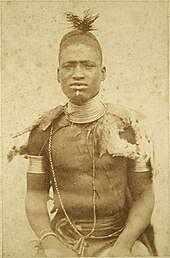 Acholi man
Acholi man Acholi family
Acholi family Acholi warriors
Acholi warriors Acholi musical instruments
Acholi musical instruments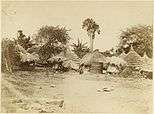 Acholi village
Acholi village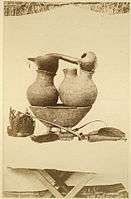 Acholi "material culture"
Acholi "material culture" Acholi chief
Acholi chief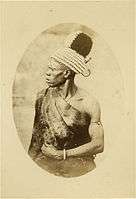 Acholi chief
Acholi chief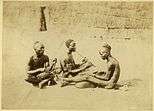 Acholi musicians
Acholi musicians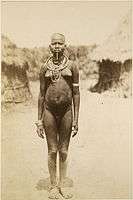 Portrait of an Acholi woman
Portrait of an Acholi woman
Lamogi Rebellion
Acholi Civil war (1986-1989)
In January 1986, the junta government of Gen. Tito Okello-Lutwa in Uganda was overthrown by Museveni and his NRA rebels. Tito and Bazilio, who were Acholi by tribe, fled the country into exile. Soon after, the NRM started pacifying the northern region, which is home to several ethnics, including the Acholi and Lango.[21][22]
The attempt to pacify the Northern Uganda was carried out recklessly with much brutality and unprofessionalism from the NRA soldiers and government.[21] This resulted in resistance building up in the region and soon a host of rebel groups sprang up in the north. Most prominent among them was the Uganda People's Army (UPA) in Teso and Lango sub region, the West Nile Bank Frontiers (WNBF) in the West Nile region, the Uganda People's Democratic Army, the Holy Spirit Movement and the LRA in the Acholi region. These rebellions sprung up in defiance and from disapproval of the conduct and legitimacy of the new NRA government.[23]
Some of the groups in Acholi, like the UPDA, detested the Museveni regime because it had overthrown the government in which they served. They were also against the power consolidation approach of the NRA, which included mass arrest, torturing, killing, cattle raiding, food crop destruction, and looting and burning of villages.[24][25]
The NRA managed to defeat all the rebel groups except the LRA which culminated in a 20-year conflict. At the peak of the conflict, 90% of the Acholi population moved into IDP camps designed as protected villages. The camps caused misery and suffering—with a conservative death toll of 1,000 people a week.[24] Conservative approaches estimates that at least 300,000 people died in the conflict that extended into the Sudan, Congo and Central African Republic.[26]
In popular culture
In 2012 the American charity Invisible Children produced a documentary about the LRA. The documentary was met with mixed reactions, with many people familiar with the situation dubbing it a shallow and money-grabbing scheme.[24] However, it successfully popularised the LRA in the West.[24]
In 2016, the multi award-winning film, A Brilliant Genocide was produced. It was filmed by Australian director Ebony Butler, Simon Hardwidge and Ugandan author Frey Onen. The documentary focused on the unofficial discourse of the LRA war and it was largely critical of the Ugandan government role in the LRA war.[27]
Notable Acholi people
- Akena p'Ojok, former UNLF Vice President, former UPC member of Parliament and Minister of Power in Obote's second regime.
- Bazilio Olara-Okello, de facto Ugandan Head of State for six months in 1985 and later Chief of Defence Forces.
- Betty Ogwaro, member of Parliament, Minister of Agriculture and Forestry in the Government of Southern Sudan, noted international political activist.
- Betty Oyella Bigombe, former MP and State Minister for Water Resources in the Ugandan Cabinet.
- Emmanuel Amey Ojara, surgeon.
- Erinayo Wilson Oryema, First Ugandan Inspector General of Uganda Police Force (1964-1971), Minister of Land, Minerals and Water Resources (1971-1973), Minister of Housing and Planning (1974 - 1977).
- Geoffrey Oryema, exiled singer and son of Erinayo Wilson Oryema.
- Janani Luwum, former Archbishop of the Anglican Church of Uganda, murdered on the orders of President Idi Amin.
- Jeremiah Lucas Opira, National Executive Secretary of the UNLF, advocate for consolidation of national unity in Uganda.
- Joseph Kony, leader of the Lord's Resistance Army (LRA), a guerrilla group that formerly operated in Uganda.
- Matthew Lukwiya, physician at the forefront of the 2000 Ebola outbreak, which took his life.
- Norbert Mao, former Chairman of Gulu District and Democratic Party Presidential Candidate in 2011.
- Okot p'Bitek, poet and author of the Song of Lawino.
- Olara Otunnu, former United Nations Under-Secretary-General and Special Representative for Children and Armed Conflict and UPC Presidential Candidate in 2011.
- Tito Okello, President of Uganda for six months in 1985 (though he referred to himself only as 'Head of State').
References
- Atkinson, Ronald Raymond (1994) The roots of ethnicity: the origins of the Acholi of Uganda before 1800. Kampala: Fountain Publishers. ISBN 9970-02-156-7.
- Dwyer, John Orr (1972) 'The Acholi of Uganda: adjustment to imperialism'. (unpublished thesis) Ann Arbor, Michigan: University Microfilms International .
- Girling, F.K. (1960) The Acholi of Uganda (Colonial Office / Colonial research studies vol. 30). London: Her majesty's stationery office.
- Latigo, James, "The Acholi Traditional Conflict Resolution in Light of Current Circumstances:" National Conference on Reconciliation, Hotel Africana, Kampala, Law Reform Journal (Uganda Law Reform Commission), 4 September 2006)
- Webster, J. (1970) 'State formation and fragmentation in Agago, Eastern Acholi', Provisional council for the social sciences in East Africa; 1st annual conference, vol 3., pp. 168–197.
Notes
- "2014 Uganda Population and Housing Census – Main Report" (PDF). Uganda Bureau of Statistics. Archived from the original (PDF) on 12 October 2017. Retrieved 17 April 2018.
- Lewis, M. Paul (ed.). "Acholi." Ethnologue: Languages of the World. SIL International, September, 2010. Accessed 10 March 2011.
- Atkinson, Ronald R. "The Evolution of Ethnicity among the Acholi of Uganda: The Precolonial Phase." Ethnohistory 1989: 36(1), p. 20).
- Doom, Ruddy and Koen Vlassenroot. "Kony's Message: A New Koine?". Africa Affairs 1999: 98(390), p. 7).
- Webster 1970.
- Atkinson (1994).
- James Ojent Latigo, Chapter 4: "Northern Uganda tradition-based practices in the Acholi region, 1. The conflict", pp. 85-89, June 2006
- "Uganda: Minorities: Acholi", World Directory of Minorities and Indigenous Peoples, accessed 3 May 2013
- Latigo (2006), "Northern Uganda", p. 90-92
- Branch, A. 2008. "Against Humanitarian Impunity: Rethinking Responsibility for Displacement and Disaster in Northern Uganda," Journal of Intervention and Statebuilding 2(2): 151-173
- UGANDA: 1,000 displaced die every week in war-torn north - report | Uganda | Refugees/IDPs, IRIN Africa
- WikiLeaks: cablegate, cable "09KAMPALA679", UGANDA/DRC: OPERATION RUDIA II UPDATE 2009-06-29 Archived 22 December 2010 at the Wayback Machine
- Latigo (2006), "Northern Uganda", pp. 102-104
- Latigo (2006), "Northern Uganda", p. 104
- Latigo (2006), "Northern Uganda", p. 108
- Latigo (2006), "Northern Uganda", p. 106
- Twesigye, K., Emmanuel (2010). Religion, Politics and Cults in East Africa.
- Latigo, "Northern Uganda", p. 97
- Latigo, "Northern Uganda", p. 98
- New Vision, 1 June 2007
- Wegner, Patrick S. (2015). The International Criminal Court in Ongoing Intrastate Conflicts. Cambridge: Cambridge University Press. doi:10.1017/cbo9781107706811. ISBN 978-1-107-70681-1.
- Gissel, Line Engbo (19 January 2018). The International Criminal Court and Peace Processes in Africa. Routledge. doi:10.4324/9781315102382. ISBN 978-1-315-10238-2.
- Behrend, Heike. (1999). Alice Lakwena & the holy spirits : war in Northern Uganda, 1985-97. J. Currey. ISBN 978-1-78204-984-5. OCLC 653038964.
- "The Anguish of Northern Uganda - Section 1 - Uganda". ReliefWeb. Retrieved 27 May 2020.
- "The Anguish of Northern Uganda - Section 1 - Uganda". ReliefWeb. Retrieved 30 May 2020.
- Atkinson, Ronald Raymond, 1944- (2009). From Uganda to the Congo and beyond : pursuing the Lord's Resistance Army. International Peace Institute. OCLC 471877660.CS1 maint: multiple names: authors list (link)
- Okumu, F. Wafula (16 July 2019). "Democratic Transitions in East Africa". doi:10.4324/9780429262401. Cite journal requires
|journal=(help)
Further reading
- Bruder, Edith. The Black Jews of Africa. History, Religion, Identity (Oxford University Press, New York 2008)
- Barber, J., Imperial Frontiers, (Nairobi: East African Publishing House, 1968)
- Caritas Gulu Archdiocese, Traditional Ways of Coping in Acholi, Report written by Thomas Harlacher, Francis Xavier Okot, Caroline Aloyo Obonyo, Mychelle Balthaard and Ronald Atkinson, 2006 (copies may be obtained from caritasgulu@iwayafrica.com)
External links
![]()
- Rupiny — A newspaper in Luo (Acholi and Lango)
- Sample of written Acholi from the Language Encyclopedia
- Documentary on a child soldier that escaped the LRA
